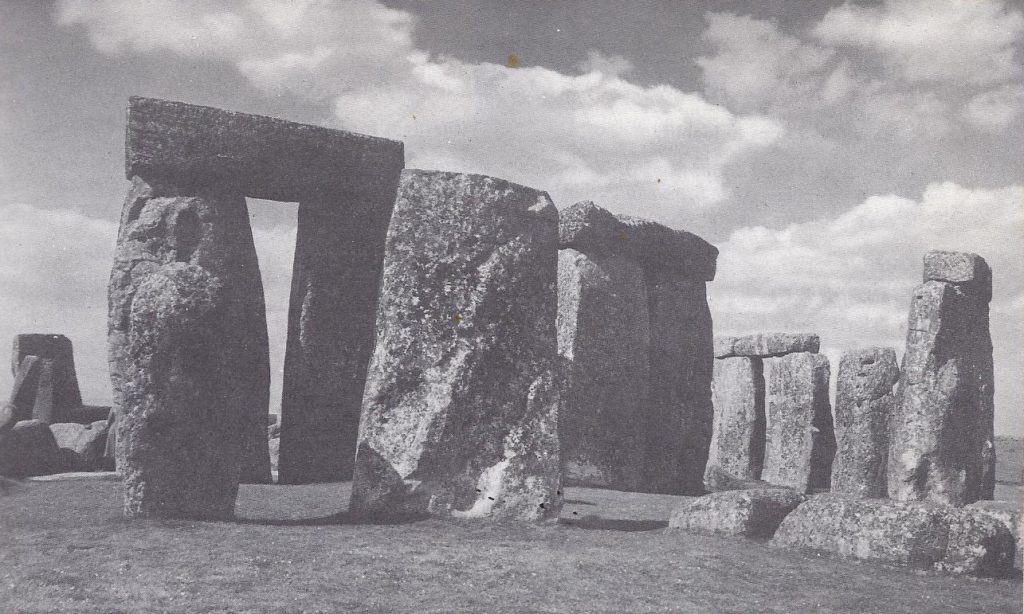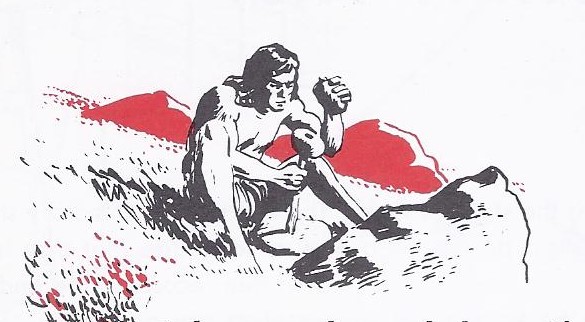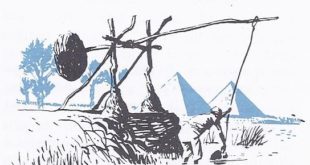Perhaps you have asked yourself, “What would I have done?” as you have read an adventure yarn or the true story of some person set down in a wild and remote spot. One of the most famous stories in the English language recounts the adventures of’ Robinson Crusoe, who was shipwrecked and cast ashore on an uninhabited island. Crusoe was completely alone and had only the few materials which he saved from the wreckage. With these and with what he found on the island, Crusoe had to provide his own food and shelter. Days and even weeks were required to fashion the simplest tools and furniture. Just to keep alive was a constant struggle.
If you stop to think of it, Robinson Crusoe possessed tremendous advantages over the men who first inhabited this earth in the dim and distant past. He, atleast, had some equipment with which to work. More important, he had thousands of years of man’s experience on which to draw. In contrast, the earliest men had none of these advantages. They did not know how to use fire, how to build the simplest of shelters, or how to fashion the crudest of tools. They had no good means of communicating with one another. They did not even know that by planting seeds they could grow food.
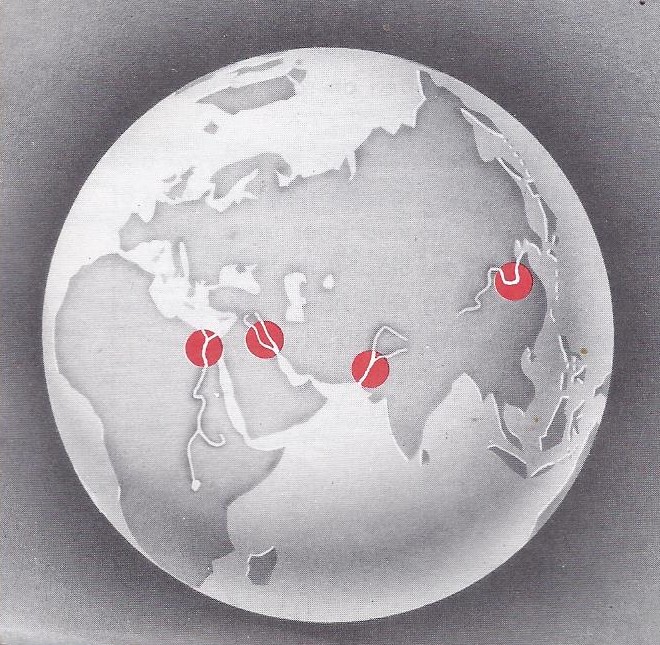
How did early peoples get the experience and develop the skills needed for civilized living?
The big questions are,
1. What was the earth like before men lived on it?
2. How did men live during the Old Stone Age?
3. What great advances were made by people in the New Stone Age?
4. How did ways of living improve in the Bronze Age?
To answer these questions.
1. What Was the Earth like Before Men Lived on It?
Our world is vastly older than mankind. How many millions of times has the earth made its yearly journey around the sun? No one knows. How long ago did human beings first appear on the earth’s surface? No one has the answer to that question either, but we do know that the earth was circling through space on its endless journey around the sun for many millions of years before any humans lived on it.
Numbers running into millions are ofcourse so huge that we cannot really understand what they mean. Let us, therefore, try to imagine the earth to be only one year old — one year of 365 days. Then only the last six hours of the final day would represent the hundreds of thousands of years that human beings have lived on this earth! Of these six hours, only one minute and twelve seconds would represent all the years since men learned to make written records — less than 5000 years ago. The time bar shows this period of 5000 years from the beginning of written history to the present. .You will notice that history since the time of Columbus occupies only a tiny space at the end of the bar.

Scientists have clues to the earth’s age. Much of our knowledge of the earth’s age comes from the work of scientists called geologists. Geologists learn about the age of the earth chiefly in three ways.
(1) They study the position and condition of layers of rock and soil, called strata. These strata furnish helpful clues to the earth’s age, for geologists can estimate when and how and in what order they were formed.
(2) Certain minerals occasionally found in rocks send out invisible rays. Very, very slowly through long ages this makes them change from one kind of mineral to another. Geologists know how long it takes to complete the change. They can tell whether the amount of change already made is small or large. In this way they can tell how old certain rocks are.
(3) Wind and water alter the earth’s surface. For countless centuries these forces have been wearing away the rocks, polishing them down, slowly cutting into them. This process, called erosion, is still another clue to the earth’s age, for geologists have calculated the rate at which erosion occurs in different places.
The Ice Age changed the earth. The earth’s surface was altered not only by the action of wind and water but also by great blankets of ice hundreds of feet thick. These ice blankets, or glaciers, formed near the North Pole. They crept slowly southward, grinding rocks and leveling hills. Where they melted, glaciers left boulders and other big rocks as well as sand and gravel and clay. It is possible even today to see these glacial rubbish heaps — geologists call them moraines. It is also possible to see the deep scratches that glaciers made in bedrock when they pushed smaller rocks over them. Such scratches and moraines serve as route markers for the geologists. They indicate the trail of the glaciers and show how far the ice sheets advanced.
At least four times during the long Ice Age, there were periods of intense, lasting cold. Between these periods, however, there were long intervals of warmer temperatures when the ice receded. Plants and many forms of animal life developed at such times. In the last cold period, the massive glaciers reached as far south as the Ohio and Missouri River valleys and covered most of central Europe and Asia. Then, about 12,000 years ago, scientists have estimated the latest ice sheet began its retreat.
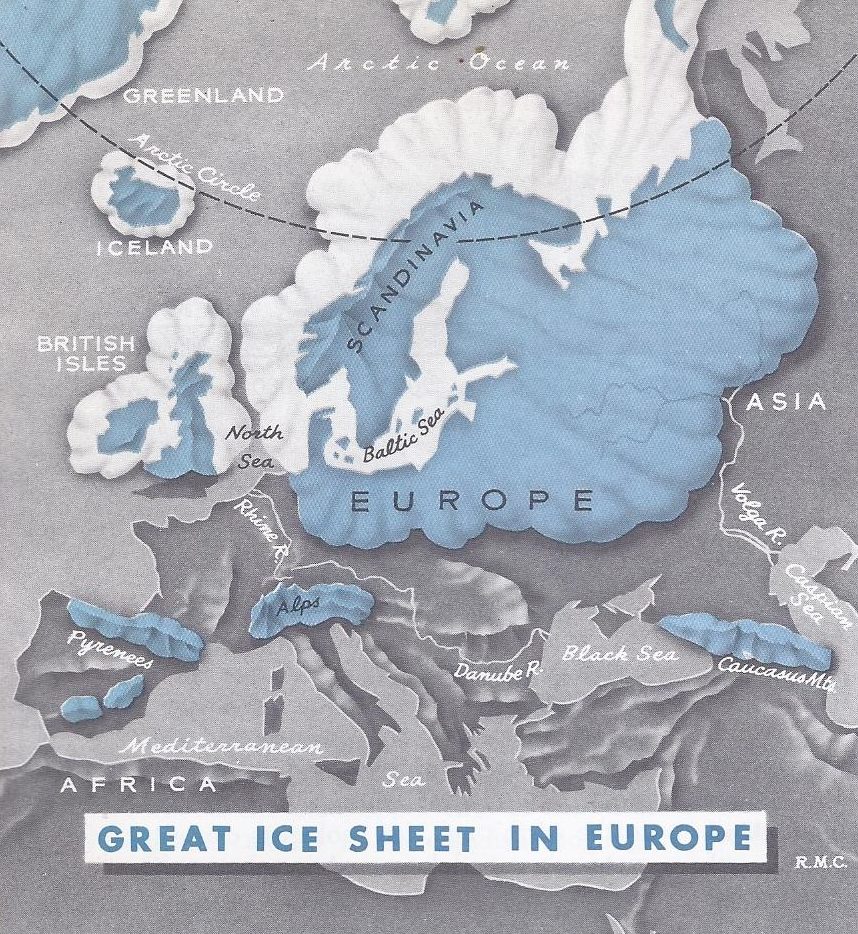
Many traces of the Ice Age remain. The ice sheet gradually melted, but did not disappear entirely. Even today glaciers inch their way down the sides of snow. capped mountains. In the high mountains of western Canada and states bordering on the Pacific Ocean there are many glaciers. Water from these melting ice sheets feeds some of the western rivers. Most of Greenland is covered by a tremendous ice blanket nearly one-fourth the size of the United States. In many places this ice blanket is over a mile and a half deep. Yet the Greenland ice cap is only a remnant of the last great ice sheet that covered much of North America, Europe and Asia. Even before that mighty frozen blanket buried so much of the earth’s surface, early types of men existed.
2. How did Men Live During the Old Stone Age?
Most at our knowledge of early man is obtained from unwritten “remains.” Although human beings inhabited the earth for many thousands of years, they did not learn to write and keep records until less than 5000 years ago. How, then, do we know about people who lived before that time? Most of our knowledge has been gathered from remains of one kind or another. Since these earlier peoples left no written records, we call them prehistoric, meaning “before written history.”
You know that detectives are often able to tell what has happened by examining various articles at the scene of a crime. Scientists, like detectives, examine remains such as arrowheads left by prehistoric men and give us a fairly clear picture of how such people lived. Scientists who dig up and study remains from the past are called archaeologists. Other scientists, called anthropologists, study physical types and groups of human beings. Anthropologists study both the people of long ago and the people of today. The discovery of more and more relics of the distant past continues to add to these scientists’ knowledge of prehistoric man.
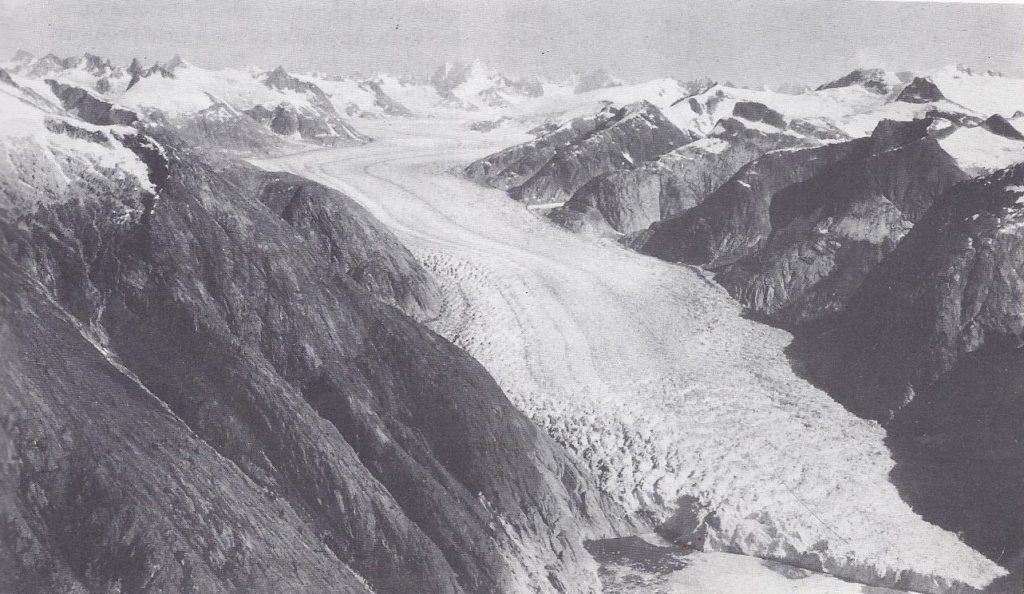
Early men left many kinds of remains. There are the graves and skeletons of the people themselves and the bones of animals they killed. There are also the crude weapons and tools they used, as well as the ornaments and works of art they created. Perhaps you have seen stone arrowheads made long ago by Indians and found in the country; or you may have seen an ivory necklace carved from animal tusks. Europe, Asia and Africa too have their relics. Paintings, some surprisingly lifelike, have been discovered on the walls of caves. Huge stones have been found arranged in patterns that could not be accidental. Many lesser remains are found buried in sand, gravel and clay, or in caves. Scientists can tell, by examining the strata where they lie, which remains are older and which belong to later times.
Primitive peoples of modern times tell us much about early man. We call any people with very simple ways of living primitive, meaning “like the first man.” Not all uncivilized men, however, lived thousands of years ago. The Indians whom the American colonists found in their country lived primitive lives. Even today there are wild tribes in remote parts of Africa and Australia that know only the simplest ways of life. Scientists learn a great deal about life in prehistoric times by studying the way in which primitive peoples live today.
The opening chapter in man’s story was the Old Stone Age. The earliest weapons and implements used by primitive people were pieces of wood and the sharpest stones they could find. Thousands of years must have passed before the first inventors actually shaped stones to use as tools and weapons. The widespread use of stone implements has caused the period in human history before the introduction of metals to be called the Stone Age. The earlier and longer part of the Stone Age, when men lived as hunters and made tools by chipping and flaking pieces of flint, is known as the Old Stone Age.
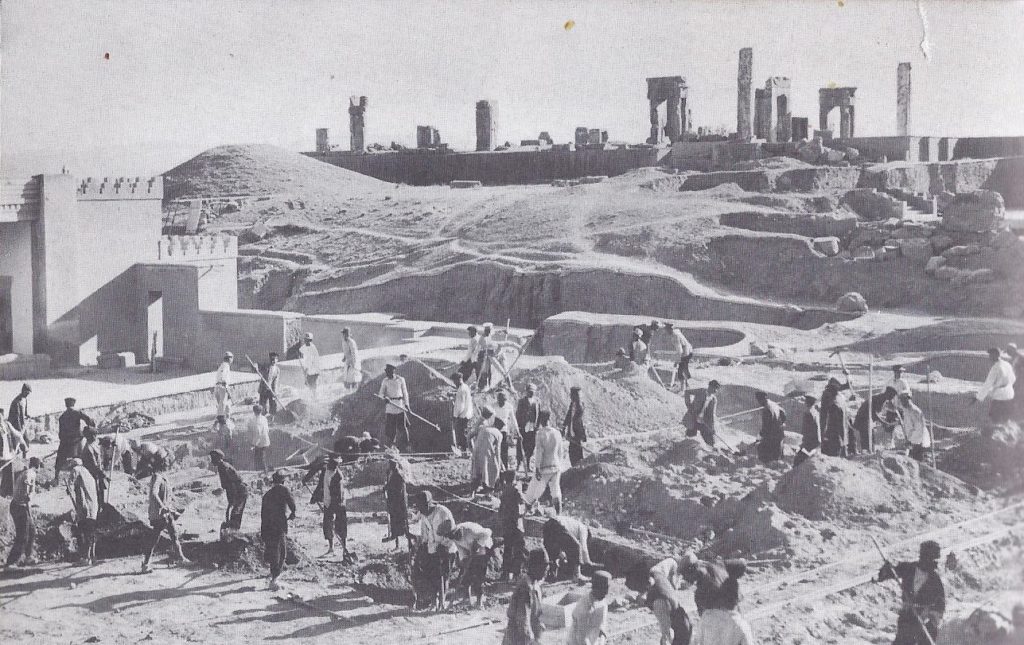
Remains of Old Stone Age Peoples are found in many parts of the world. Remains of these early people have been found in many places, but by far the earliest remains of men and their tools known today come from East Africa, which may have been the original home of the human race. Besides tools, Old Stone Age achievements included the use of fire, the making of clothing, containers were made from skins, shelters from brushwood and the use of speech. These Old Stone Age inventions may have been made independently by widely scattered people during the Ice Age. Remains of early peoples stone and bone implements and parts of skeletons — have been found beneath the sand and gravel left by retreating ice sheets.
Discoverers of such remains find it convenient to label them with the names of the places where they are unearthed. Thus, the term “Java Man” refers to fragments of early men found in Java. The map shows where some remains of early men have been found in Java. The map below shows where some of the remains of early man have been found.
The long climb to civilization began in the Ice Age. The anthropologists who study the skulls, bones and teeth of these early men find that prehistoric people were not of the same physical types as modern man. The oldest complete skeletons date back over 70,000 years. At that time there lived in Europe and Asia a type of man called Neanderthal. He is given this name because the first example of his type was dug up in the Neander valley (that is the German word for “valley” ). Neanderthal men apparently were short, heavily built people, little more than five feet tall. They walked with a slouch, swinging their long, powerful arms. Their deep-set eyes peered from beneath sloping foreheads. They had round, receding chins. Compared with modern types of people, the Neanderthal men and women were ugly and brutish looking. Yet they were true men with large brains.
These Neanderthal people evidently learned to use fire for warmth and for protection against the fierce animals that roamed during the Ice Age. Neanderthal men also learned how to fit handles to their rough hatchets of chipped stone. By tying stones which they had chipped to a point onto wooden handles or shafts, they created crude knives and spears. These early people were slightly less savage than the beasts they killed for food and clothing.
Late in the Ice Age another type of early man appeared. About 30,000 years ago types of men much like ourselves spread over Europe. One type we call Cro-Magnon because their remains were first found in a cave of that name in the south of France.
Cro-Magnon people appear to have been quite like people of today in build and in shape of head. A Cro-Magnon man, if one were alive and wore modern clothing, would perhaps pass unnoticed on a crowded street. People of this type came from northern Africa and western Asia into Europe. Fragments of skeletons, however, which date back to earlier periods of the Ice Age show that people somewhat like Cro-Magnon men were already living in Asia and Europe at that time.
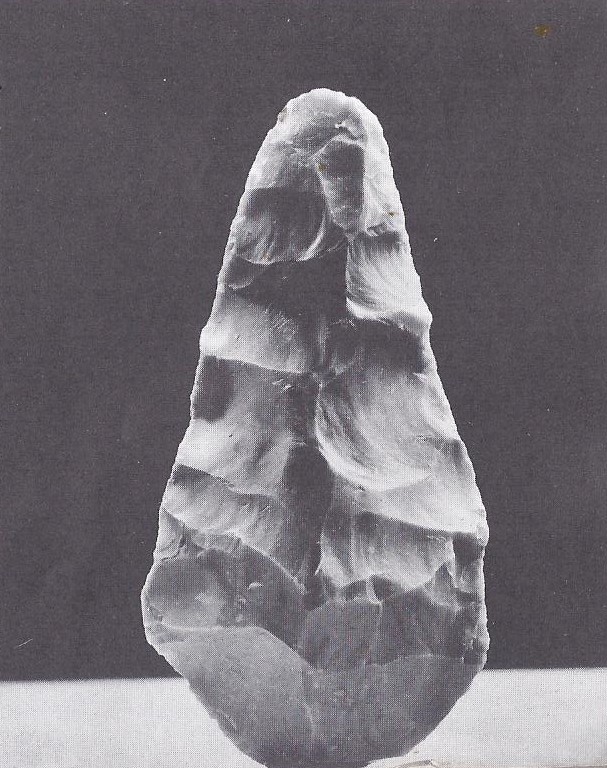
The tall, broad-shouldered Cro-Magnons made far better stone and bone implements than the earlier Neanderthal people. The Cro-Magnons were great hunters. Perhaps it was they who first invented the bow and arrow. Among the Cro-Magnons there were real artists, too. On walls of caves these prehistoric painters drew many life-like pictures of bison, reindeer, wild horses and the huge mammoths — beasts that resembled overgrown elephants. Some of these pictures were only outlines, but others were colored red, yellow and black. The ancient cave painters worked by the flickering, smoky light given off by animal fat that burned in crude lamps of hollowed stone.
What happened to the Cro-Magnon people? Again there is mystery. It may be that the answer lies hidden among remains still to be uncovered. Nobody knows.
Life was difficult in the Old Stone Age. The Old Stone Age, as you have read, was the earliest period in man’s past. Old Stone Age men gradually learned: (1) to make crude weapons and implements of stone and bone; (2) to make use of fire for cooking, warmth and protection; (3) to talk and thereby exchange ideas; (4) to use animal skins for clothing; (5) to use caves and crude huts for shelter. Moreover, these early men learned to work together in small groups. They learned that co-operation was often the only way to survive amid the dangers that surrounded them on all sides.
Nevertheless, Old Stone Age men remained savages. They grew no food and had no tamed animals, except possibly dogs. For meat they ate animals they caught or found dead or wounded. (No doubt these savage people sometimes ate one another.) For fruits and vegetables they helped themselves to what grew wild because they knew nothing about farming. When wild animals and plants were scarce, these people either starved or moved on in search of food. Old Stone Age hunters and food gatherers were constantly on the move, for a large area was needed to provide enough food for even a few people. Under such conditions, life was fearfully hard, dangerous and uncertain. For all of these reasons, Old Stone Age people were few in number and there were no villages or towns as we know them.
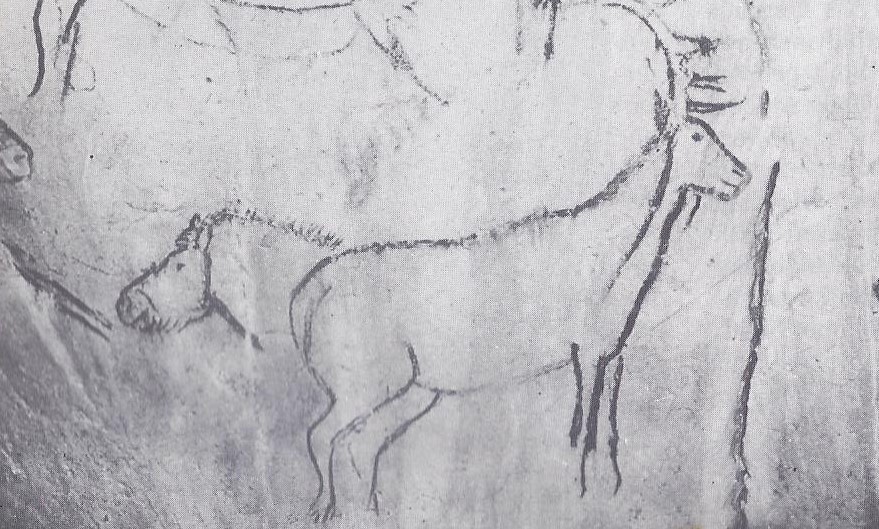
3. What Great Advances Were Made by People in the New Stone Age?
When the last great ice blanket that covered much of Europe, Asia and North America began to melt, the climate slowly changed. New types of animals and plants appeared. A new period of warmth began, in which we now live. With this new warmth began the New Stone Age, about 10,000 years ago. The New Stone Age made its greatest progress in parts of Asia near Africa and parts of Africa near Asia.
New and improved articles came into use during the New Stone Age. The name New Stone Age refers to the fact that people hit upon ways to make better implements of stone. They continued to chip and flake pieces of flint as had Old Stone Age men. The New Stone Age men went a step further; they used wet sand to grind and polish a great variety of stone and bone implements. Among these were stone axes and hammers pierced with holes for wooden handles. (The best Old Stone Age men had done was to tie handles to implements.) We inherit the shapes of our modern steel axes, hammers and chisels from the New Stone Age tool makers. They also made beautifully ground stone and bone knives, spear points, arrowheads and needles.
Farming and grazing appeared. Besides making better tools and weapons, New Stone Age people found new ways of getting food. About 10,000 years ago they learned to plant wheat and barley. As time went on, they added new grains, vegetables and fruits to their cultivated crops. New Stone Age men also learned to tame wild goats and sheep and used them as sources of food and clothing. So men no longer had to depend for food entirely upon hunting and upon the wild fruits and vegetables they could find. They became food producers, rather than mere food hunters and food gatherers. In other words, New Stone Age men were beginning to learn how to control natural resources for their own benefit.
The discovery of agriculture is considered so important that some anthropologists now emphasize it more than the development of improved tools. These anthropologists prefer to classify ancient man’s development in terms of agriculture rather than by divisions of the Stone Age. To support this approach, they point out that people in some parts of the world started to farm even before they learned to grind and polish stone implements.
Permanent settlements developed. New Stone Age men discovered that their plants grew better when weeded and watered. Moreover, with good crops they did not have to wander in search of food. So they built permanent shelters or homes. Their flocks and herds provided a year-round supply of meat and milk. Then surplus grain was stored for use when food was scarce. Life, in short, became easier and more secure. The same area could now feed a larger population than it could before the days of farming and herding. Near the farm lands, villages grew in number and size. With village life came the need for rules and regulations. To meet this need, simple forms of government developed. Often the fighting men formed a council under the leadership of a headman or chief.
Cloth and leather came into wide use. Other crafts and occupations developed among New Stone Age people. In the Old Stone Age women probably had learned to weave reeds and grasses into crude baskets. People of the New Stone Age learned how to twist the wool of sheep into yarn. They also learned to make linen threads from the flax plant. These they wove into woolen and linen cloth for clothing. Weaving became an important household task. Many examples of woven goods dyed in various colors, as well as lengths of cord and rope, have been found in places where New Stone Age villages stood. Woolen and linen cloth did not entirely replace animal skins for clothing, but better ways were found of making these skins into leather, which came into wide use.
Improved methods of making pottery were invented. Possibly it was by accident that baked clay was found to be permanent and waterproof. Perhaps the first step was to smear a basket-like framework with clay and bake it in the fire. The basket framework burned away, leaving a hard basket-shaped clay container. At first, pottery makers copied the forms of woven baskets. Later they learned to shape the clay into other forms, making a wide variety of crude bowls, cups, vases, plates and jugs. After centuries, pottery makers learned special uses for special kinds of clay. They also learned how to polish and paint their products. Pottery making, like weaving, became an important household industry.
Some men became traders. Most of the New Stone Age people were self-sufficient; that is, they produced all their own food, clothing and implements. There were some who needed better stone for making implements, or more wool, or perhaps more sheep or goats. In addition there were many people who wanted pretty objects like sea shells for ornaments. In exchange for these articles, such persons could give surplus products of their own making — extra grain, linen cloth, or leather.
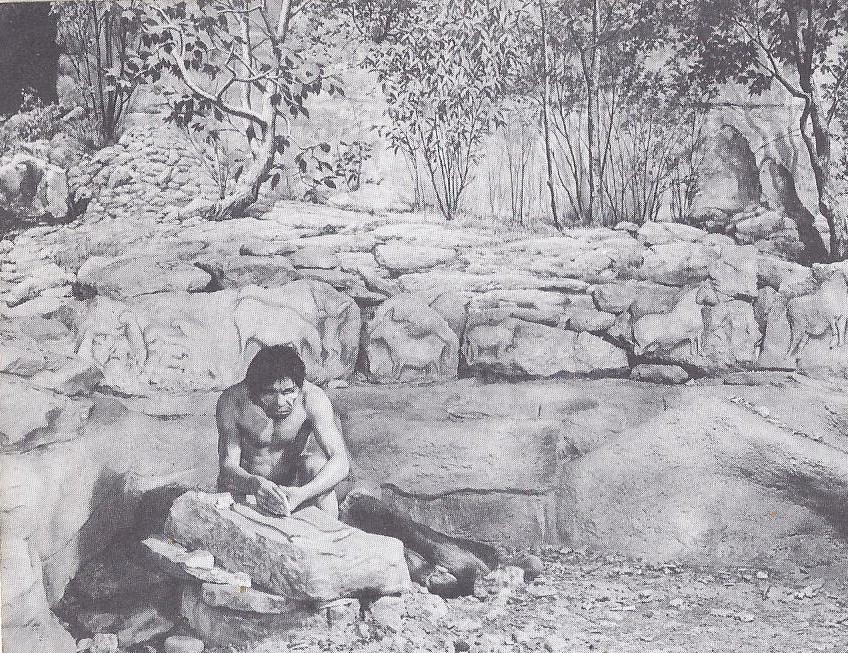
At first, New Stone Age men began to exchange articles with neighbours or with people in nearby villages. Then these products were carried to greater distances by traders who made a living by exchanging goods with other people. On land the traders traveled along well-beaten paths, leading heavily laden donkeys or carrying goods themselves. Traders also traveled across lakes and down rivers on rafts, in boats made of hollowed-out logs, or in tiny craft that were nothing but animal hides stretched over light frames of wood.
More daring traders crept along the seacoast in vessels that were not much larger. These traders carried not only the goods they exchanged; they passed along the ideas which they had picked up from other people. The ideas they carried were as important in advancing human progress as were the goods they traded.
Some men became specialists in producing certain goods. The man who made the best leather goods, the best stone implements, or the best bows and arrows was likely to have no trouble exchanging his extra products. Men who lived near the chalk quarries where flint was found dug out pieces of flint and made them into highly desirable axheads. Other craftsmen exchanged the products they made best for food, clothing and other necessities. In this manner specialized occupations came into existence. With craftsmen to make goods and traders to exchange them, people no longer had to struggle to supply all their own needs.
Climate and soil led some people to become herdsmen. Not everybody was willing or able to settle down to farming. Nor could all people who were not farmers become either craftsmen or traders. Where there was scanty rainfall and poor soil suited only to growing grass, the people were shepherds or herders. Often they had no other choice. At times they had to wander for long distances to find grass for their sheep or goats. Such wandering people are called nomads. Nomads are to be found to this day on the grassy fringes of the African and Asiatic deserts or roaming the vast grassy plains of central Asia. Over the centuries, nomads have continued to live much as their ancestors did thousands of years ago.
Language differences developed. People differed not only in the way they made a living but also in the way they talked. Old Stone Age men had discovered words and speech, but their languages must have been quite simple. As living conditions became more advanced, so did language. (Even in our own times, languages continue to grow and change.) Men had to communicate new ideas and plan new projects. In short, they had much more information to pass on to others in the New Stone Age. Not all groups of people spoke the same language. Why should they? They had lived far from each other, so the same sounds came to have different meanings for different groups. It was in the New Stone Age that the different languages of today had their beginnings.
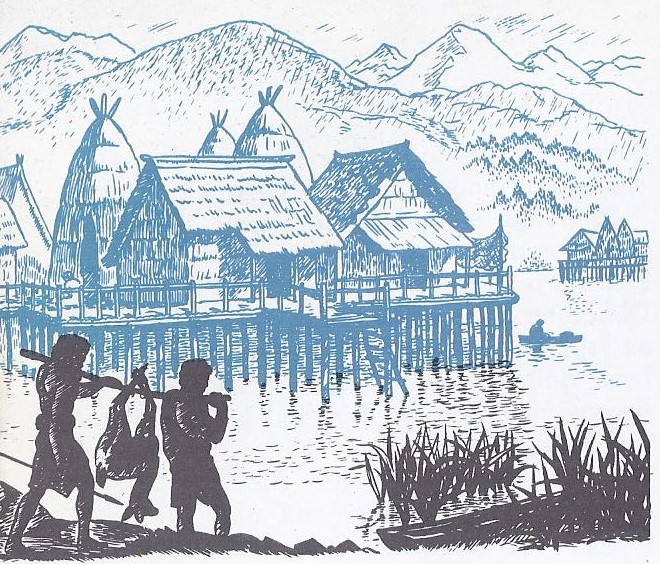
Religion played an important part with prehistoric men. There is proof of religious beliefs among early peoples. Even before the close of the Old Stone Age, the dead often were buried with considerable care. In many graves archaeologists have found weapons, ornaments and remains of food. These graves show us that Old Stone Age people believed the dead would need such things in a life after death. In the New Stone Age the practice of burying things of value with the dead became common. Sometimes family graves or the graves of important people were made in the form of log or stone houses with peaked roofs. Weapons, clothing, ornaments and food were placed there. Then the grave houses were covered with huge mounds of earth. Today these burial mounds, or barrows, are treasure houses of information about the people who built them.
There is also evidence that prehistoric people believed in some higher power or being who could do them harm or good. Apparently they had religious ceremonies of some kind. Great stones set upright and sometimes placed in huge circles, may have been used as places of worship. Other huge stone slabs, resting on smaller stones like a giant’s table, probably served as tombs.
Man made great progress in the New Stone Age. Everyone has thrown a stone into a quiet pool of water and watched the ripples spread in ever-widening circles. In much the same manner the ways of living developed by the New Stone Age men spread. Sometimes, as you have seen, ideas were carried by traders; sometimes they were spread by groups of people, “pioneers” who moved to nearby regions in search of new farm lands. In this fashion, the all-important “know-how” of New Stone Age people spread widely over parts of Asia and the continent of Europe.
As a result of these gradual changes in the New Stone Age, people were far more advanced than the savages of the Old Stone Age. They lived more comfortably and securely in settled villages. They had permanent houses of wood or of bricks made of sun-dried clay and straw. Their farms and herds provided more and better food. Weavers made better clothing and potters made better utensils. Handicrafts –simple manufacturing with hand tools — increased. There was more trade. Religious ideas had taken form; and great stone monuments show us that New Stone Age People had begun to develop engineering skill. Moreover, simple law and government were developing.
This was real progress. Yet we would not say that New Stone Age people were truly civilized. They possessed no adequate method of writing. They had few materials they could use for clothing or for shelter. They knew little about metals, so their tools were clumsy. They lacked the knowledge and skills to make a living except in a few simple ways. New Stone Age men had a long way to go to overcome such handicaps. But nearly 6000 years ago, in some places, the march of progress had begun.
TIME-TABLE EARLY MAN
The Old Stone Age began — possibly about 1,000,000 years ago.
Early men were living in many lands – about 500,000 years ago.
Neanderthal Man inhabited much of Europe and Asia -about 100,000 years ago
Modern Man spread over Europe — about 30.000 years ago
The New Stone Age began — about 10,000 years ago
Village life began — about 8000 years ago
The Bronze Age began — between 6000 and 5000 years ago
Men learned to keep records; recorded history began –about 5000 years ago
Because early men left no written records, these are rough time estimates, reached by scientific methods.
Man Learns to Create
In 1940 some boys from a village in southern France were poking around a fallen tree when, under its roots, they found a dark opening in the ground. Cautiously, they slid down the hole — ten feet — fifteen feet — twenty feet — until they touched bottom and found themselves in a cave whose walls were decorated with the mysterious drawings shown above. News of the boys’ discovery spread and archaeologists hurried to explore the so-called Cave of Lascaux. They identified the drawings as the work of Stone Age artists who had lived between 10,000 and 30,000 years ago. These silhouettes of wild horses and oxen, said the archaeologists, were some of the first pictures ever created by man.
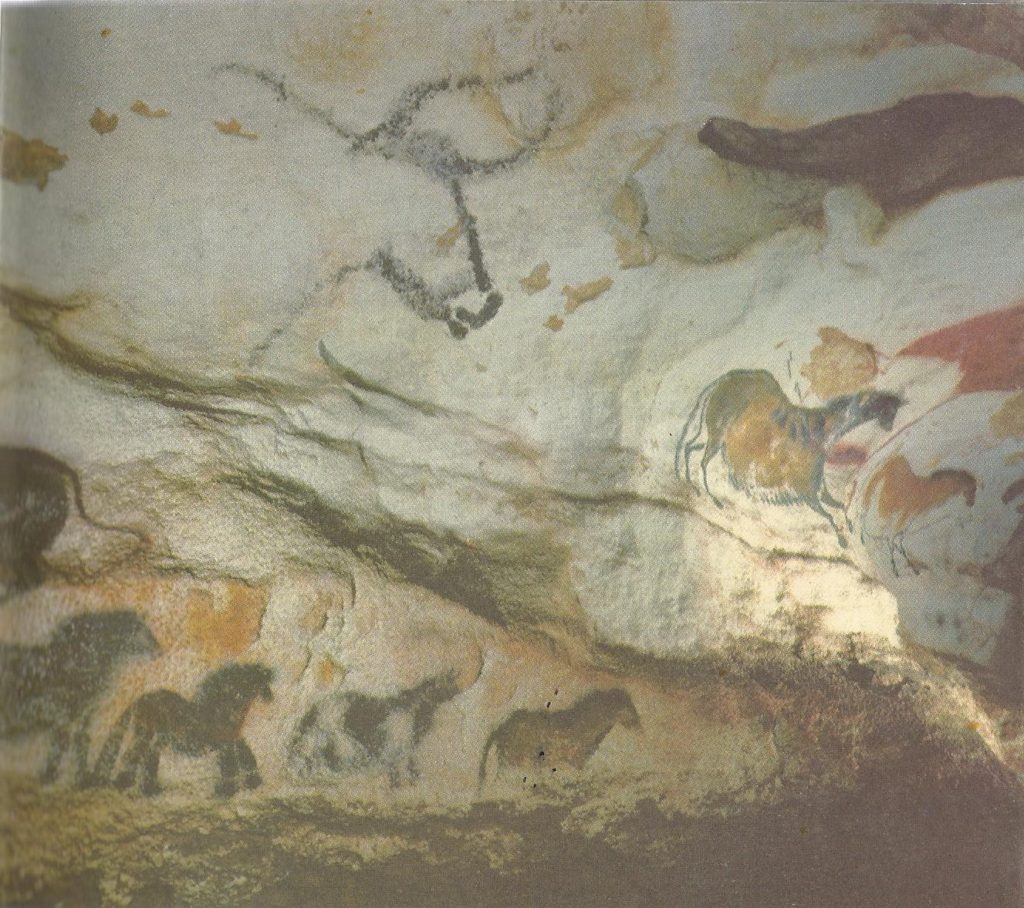
Stone Age men created pictures to help them fill their most important need — food. They got most of their food by hunting wild animals and it is believed that they drew pictures of animals as a kind of magic to make game plentiful or to give them good luck in hunting.
In the some way, other things created by early man reflect his other needs. For example, primitive people on all continents needed shelter. The first shelter was nothing more than a crude lean-to of branches. Later, man learned to build bigger structures. Instead of sheltering one family, they were strongholds for a whole tribe, like those built by the Cliff-Dwellers in the American Southwest.
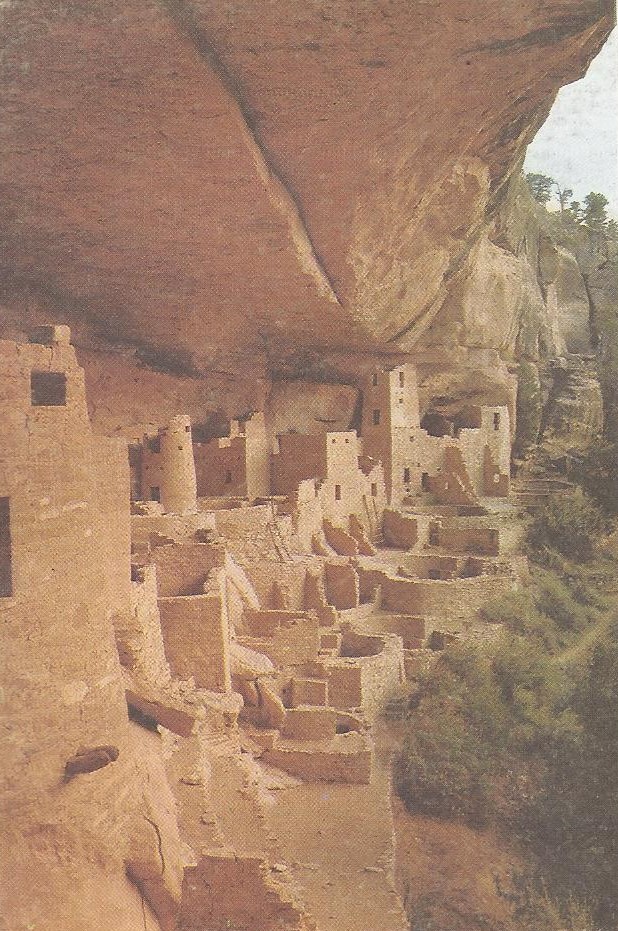
People also needed clothing to protect themselves from the cold and rain. At first they simply tied animal skins around their bodies. As soon as women learned to sew and to weave cloth, the human love of color and beauty came into play. Look at the complicated pattern of a shawl embroidered by the ancient Indians of Peru. We know almost nothing about how these people lived. By studying shawls like this which the Indians buried with their dead, our scientists have discovered that they dyed wool in 190 different shades to get their rich color combinations. This fact proves that from the very beginning man was inspired to improve things and to make them as attractive as he possibly could.
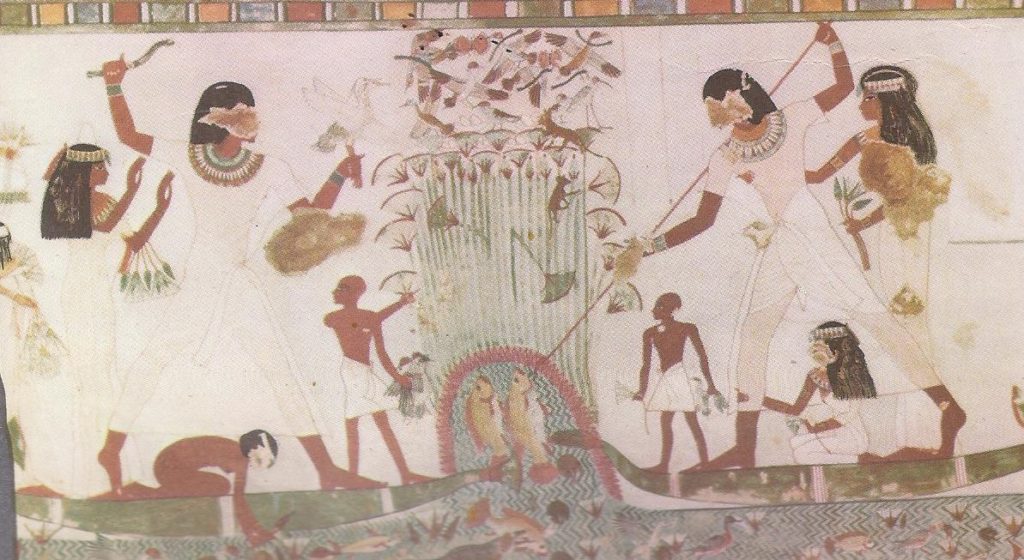
In the ruins of almost every ancient village, archaeologists have dug up handmade Pottery bowls, dishes and pitchers. Sometimes it seems as if early man made more pottery than anything else! The people used these containers in everyday life, just as we use pots and pans, cardboard boxes and cellophane bags. Early women needed utensils in which to carry water, to cook meals and to store the berries and seeds they gathered. The mothers of ancient times also needed something to keep the children amused. So early craftsmen modeled clay toys, like those shown above, which were found buried in an ancient city in India.
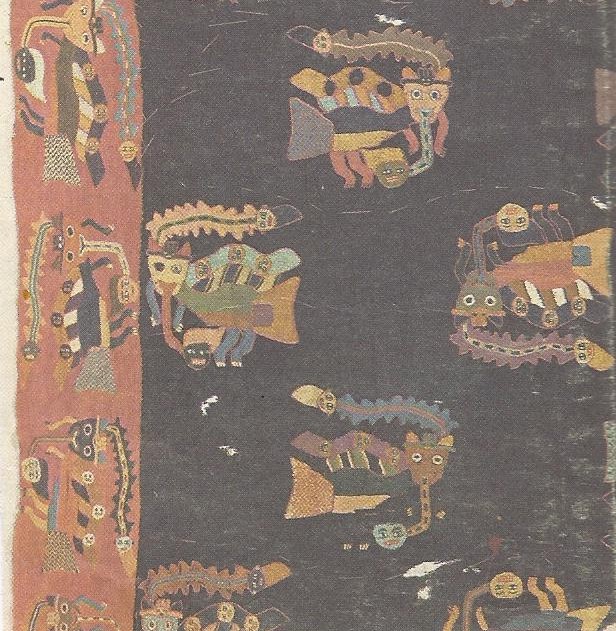
It may surprise you to learn that the first things which man created out of metal were probably not tools or weapons, but ornaments. In early times men as well as women loved jewelry. Relatively soft metals like copper or gold were heated and hammered into simple beads and bracelets. Gradually, ancient goldsmiths learned to shape larger obiects, like the collection found in the tomb of a queen who reigned in the Mesopotamian city of Ur 4500 years ago.
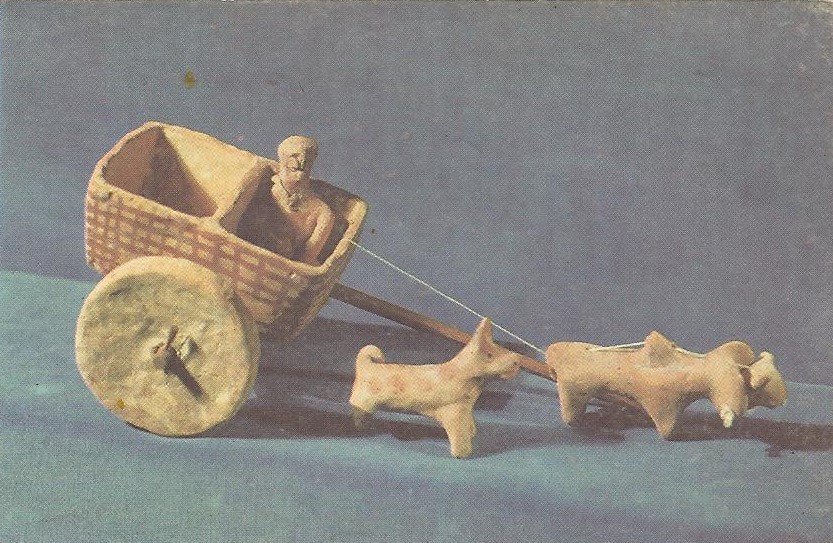
Men and women at the dawn of history made beautiful things not only for themselves but to honour their gods. The gods deserved the best they had to offer. For example, bronze is a harder metal than gold or pure copper and so is more useful for tools. In prehistoric China, as far as we know, the first bronze was not used for tools. Instead, it was cast into handsome dishes to hold the offerings which the Chinese placed on their altars like the pitcher shown.
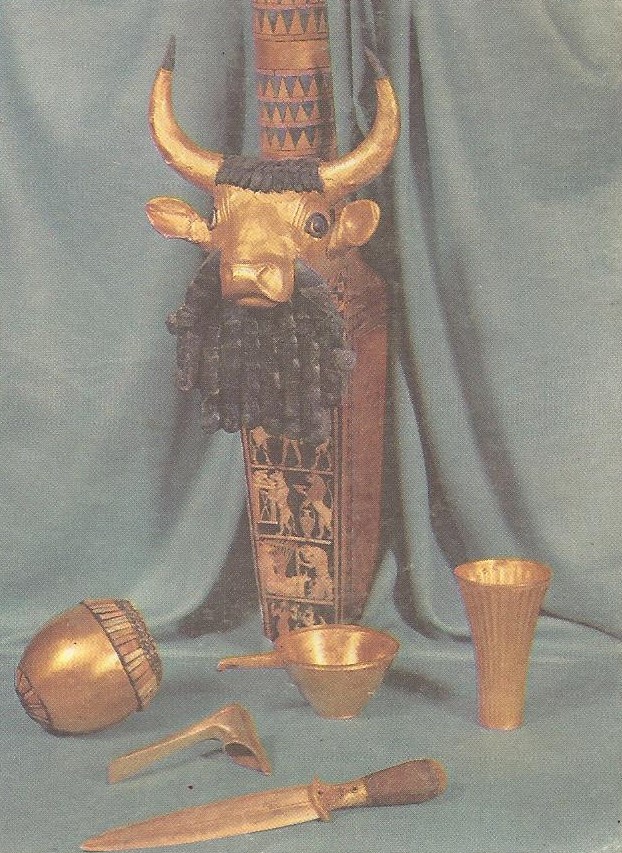
You can see from the examples that the things made by man grew more elaborate as time went on. This is because man learned to meet his basic need for food by agriculture, instead of by constantly hunting and fishing. In the warm river valleys most people worked in the fields and were able to grow enough food for all. This freed at least a few people to specialize in the other arts and crafts of civilization. The increase in extra time is reflected in the paintings which the early Egyptians left on the walls of their tombs. Often Egyptians are shown enjoying themselves, as in the hunting and fishing scene below. For the Stone Age men who pointed the pictures, hunting was a grim fight for food. The Egyptian shown, however, was not a professional hunter but a government official with enough leisure time to hunt for sport. Notice that he is wearing his “holiday outfit”– fancy collar and clean linen — and that he has even brought his children along for a pleasant outing.
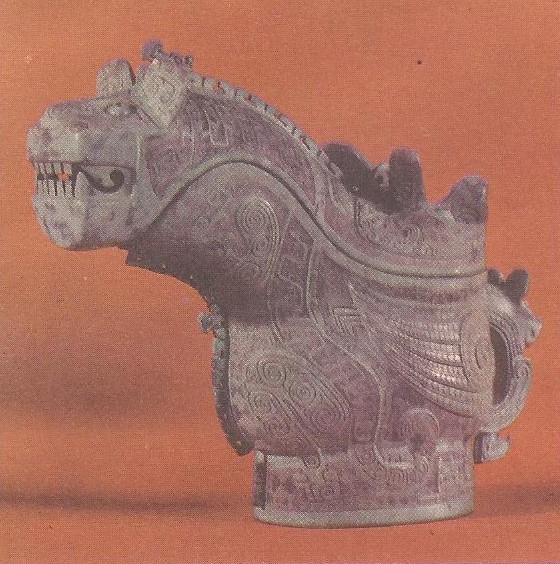
4. How Did Ways of living Improve in the Bronze Age?
Try to imagine what our life would be like with no metals of any kind. We would have no railroads, no automobiles, no telephone or telegraph or radio or television. There would be no structural steel for skyscrapers or bridges. Countless articles used in our daily living just would not exist. Although we use many kinds of metal today, so widespread is the present day use of steel that we say we live in an Age of Steel. Some people even say that the Age of Lightweight Metals (such as aluminum) is here, for one metal constantly replaces another.
Metal implements were produced. Man’s earliest use of metals came not through iron and steel, but through copper, tin and then bronze. It was in the hilly regions of southwestern Asia and nearby North Africa that men first learned how to make tools and weapons of metal. Copper and tin were easily mined because they were found in the earth in a pure, or almost pure, form. These metals could be used for ornaments, bowls, plates and vases, but were too soft to make good hammers, axes and knives. Yet, melted together in the right amounts, copper and tin were found to make a tough, hard metal known as bronze.
With bronze, many articles far better than those of tin or copper or stone could be made. Metalworking in bronze became a special craft and bronze goods became important items in trading. What is known as the Bronze Age began about 5000 years ago. Slowly the use of bronze spread to other parts of the world. Many peoples, however, continued to live in the Old or the New Stone Age for hundreds or even thousands of years after more advanced people’s had progressed into an age of metals.
Agriculture advanced during the Bronze Age. People who lived in the Bronze Age made other important advances, some of which had to do with farming. Without water most plants perish, yet too much water washes soil away. Not until Bronze Age days did farmers find answers to these twin problems. Where there was little or no rainfall, the Bronze Age farmers learned to dig ditches to carry water from lakes or streams to their fields. They also found they could protect their farm lands from floods by building dikes of earth to hold back water. Moreover, Bronze Age people had tame cattle which they sometimes used to draw wooden plows. These plows would seem clumsy to us. They were, however, a great improvement over sharp sticks or hoes with cutting edges of stone. A more certain supply of water and better implements made it possible to plant larger fields and harvest bigger crops.
Wheels helped move loads. Perhaps you find it difficult to think of doing without iron and steel. Where would we be without wheels — wheels on wagons, wheels on cars and trucks, wheels on trains, wheels on airplanes? We also need wheels for countless uses in our factories.
The wheel was invented about 6000 years ago. Probably two-wheeled carts with heavy wheels of solid wood came first. In time lighter-weight chariots with spoked wheels were used in warfare. Four-wheeled wagons drawn by cows, oxen, or donkeys were used for carrying heavy loads. (Horses were unknown in south western Asia until about 4000 years ago, and camels were not used till a thousand years later.)
The potter’s wheel was invented. Improved bowls and utensils were made possible by the invention of the potter’s wheel. This horizontal disk, which rotated on a central pivot, was turned by the potter as he shaped his clay on it. Later, potters spun the wheel by means of a foot treadle. With a potter’s wheel, the craftsman could make far more evenly and gracefully shaped articles of clay. Pottery became a special craft carried on by men instead of women. Like the bronze workers, potters began making products which traders bought and sold.
Seafaring commerce developed. If you look at the map, you will see that sailors from Egypt might easily reach Asia Minor by way of the Mediterranean. From there the voyage to Greece is short, with many islands for stopping places. Boats could also follow the shore of Asia Minor to the Black Sea. East of the Black Sea travelers could cross overland to the great landlocked Caspian Sea. Across the Caspian Sea, routes to India and China began. Those Eastern countries could also be reached by sailing south through the Red Sea and then all the way by water.
Such journeys look fairly simple when you glance at the map today, but Bronze Age traders had no such maps. In fact, they knew little or nothing about these water routes. Moreover, before they could discover such trade routes, men had to learn to build ships large enough for safe travel on the seas. Where Stone Age men had traveled only for limited distances, Bronze Age men became more daring. They discovered that they could move heavy ships through the water by letting the winds push against a sail held aloft by an upright pole or mast. Heavy oars provided snail-like speed when the winds failed. Smart sailors learned when and in which direction the prevailing winds blew and planned their voyages so as to take advantage of them.
Systems of writing were invented. To keep records of business transactions, of rules, laws, events and to communicate with people at a distance, men invented writing. The earliest system was picture writing, each little picture representing a definite object. Tribes such as the North American Indians used picture writing. In Asia and Africa, however, picture writing was greatly improved upon and simplified.
As soon as men invented a system of writing which enabled them to record their experiences and preserve knowledge for later generations, the historic period began. We should remember that in early historic times only a very small number of people were able to read or write.
Religious beliefs took on greater importance. As people made progress toward better living, they asked themselves why there were forces in nature which they could not control. What made storms? What caused drought? What were the reasons for the rising and setting of the sun and the changes of the moon?
Stone Age men had believed these events to be the work of superhuman powers. In the minds of Bronze Age men these powers took on definite shape and characteristics and became gods. These gods, of course, could help or hurt. So men sought the favour of the gods by gifts and prayers. Often each village had its particular set of gods as well as its own temple. A separate class of people the priests and priestesses, served these gods by conducting religious services.
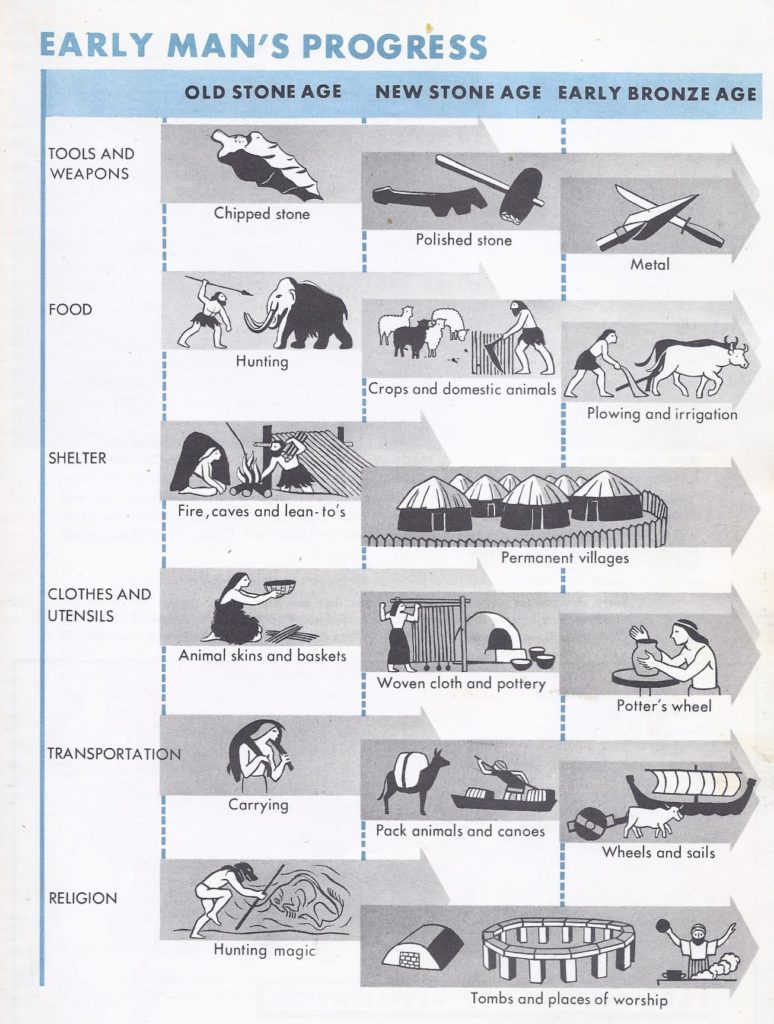
Civilized ways of living first developed in great river valleys. We have followed the story of the slow and laborious advance of early peoples through the Old and New Stone Ages into the Bronze Age. Peoples in all parts of the world, as you know, did not progress, at the same rate. The change to civilized ways of living took place first of all in four great river valleys. One was the valley of the Nile, another the valley of the Tigris and Euphrates. Two other very old civilizations were in the valleys of the Indus and Yellow Rivers. Located on the map below.
Little is known of early civilizations in India and China. As yet we have not learned much about the first civilizations of the Far East. About forty years ago archeologists discovered remains of a lost civilization in northwestern India in the valley of the Indus River. They unearthed what was left of two once-flourishing cities, known today as Mohenjo Daro and Harappa. These had wide and regular streets, buildings of fire-baked bricks, good water supply and drainage systems.
Discoveries indicate that among the inhabitants of these two cities were craftsmen who wove cotton cloth and made fine jewellery, metalwork and pottery; and traders who exchanged goods with far distant peoples. These cities apparently were the centres for a prosperous farming region along the Indus River. Beyond these scanty facts, however, the beginnings of civilization in the Indian peninsular are shrouded in mystery. We do not even know the names of these early Indus Valley people or what happened to them. For some reason they abandoned their cities in the Bronze Age. The land became a barren desert and the cities were buried in sand.
We also know little about the early peoples of China. What we do know is pieced together from legends and stories rather than from remains. China was inhabited by men of the Old Stone Age and also by primitive farmers of the New Stone Age. A Bronze Age civilization did develop in northern China in the plain of the Yellow River, but probably at a later time than in the other three river valleys. Its people raised crops of wheat and millet, had tame animals, produced excellent bronze work, pottery and used shells for money.
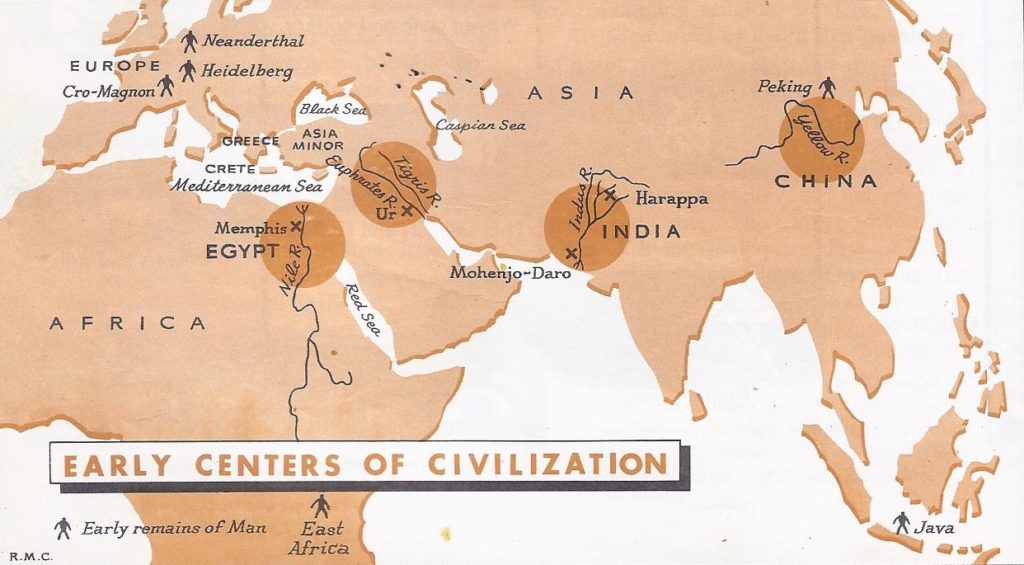
Civilizations in the Nile and Tigris-Euphrates valleys were more advanced. We know a great deal more about what happened in the valleys of the Nile and the Tigris-Euphrates. Here metals were first put to use and civilization began earlier and advanced more rapidly. Between 4000 and 3000 B.C. many flourishing towns and cities grew up along the banks of these rivers. The Nile and Tigris-Euphrates valleys, are cradles of the civilization of our modern Western world (Europe and the Americas).
